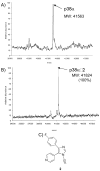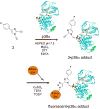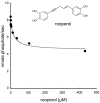A fluorescence-based assay for p38α recruitment site binders: identification of rooperol as a novel p38α kinase inhibitor
- PMID: 23225637
- PMCID: PMC3775607
- DOI: 10.1002/cbic.201200529
A fluorescence-based assay for p38α recruitment site binders: identification of rooperol as a novel p38α kinase inhibitor
Abstract
A new p38α inhibitor: Using a D-recruitment site (DRS) probe for p38α which exploits covalent interaction with Cys119 and alkyne-azide "click" chemistry to identify small molecules that recognize the p38α DRS, the anti-inflammatory natural product rooperol was identified as a novel p38α inhibitor.
Copyright © 2013 WILEY-VCH Verlag GmbH & Co. KGaA, Weinheim.
Figures










Similar articles
-
Syntheses and structure-activity relationships for some triazolyl p38α MAPK inhibitors.Bioorg Med Chem Lett. 2014 Mar 1;24(5):1352-7. doi: 10.1016/j.bmcl.2014.01.034. Epub 2014 Jan 28. Bioorg Med Chem Lett. 2014. PMID: 24508134
-
Tri- and tetrasubstituted imidazoles as p38α mitogen-activated protein kinase inhibitors.Bioorg Med Chem Lett. 2010 Nov 15;20(22):6671-5. doi: 10.1016/j.bmcl.2010.09.012. Epub 2010 Sep 9. Bioorg Med Chem Lett. 2010. PMID: 20934337
-
Development of a fluorescent-tagged kinase assay system for the detection and characterization of allosteric kinase inhibitors.J Am Chem Soc. 2009 Sep 23;131(37):13286-96. doi: 10.1021/ja902010p. J Am Chem Soc. 2009. PMID: 19572644
-
FLiK: a direct-binding assay for the identification and kinetic characterization of stabilizers of inactive kinase conformations.Methods Enzymol. 2014;548:147-71. doi: 10.1016/B978-0-12-397918-6.00006-9. Methods Enzymol. 2014. PMID: 25399645 Review.
-
Unique MAP Kinase binding sites.Biochim Biophys Acta. 2008 Jan;1784(1):48-55. doi: 10.1016/j.bbapap.2007.09.016. Epub 2007 Nov 19. Biochim Biophys Acta. 2008. PMID: 18068683 Free PMC article. Review.
Cited by
-
Pseudo-four component synthesis of mono- and di-benzylated-1,2,3-triazoles derived from aniline.Molecules. 2013 Dec 20;19(1):55-66. doi: 10.3390/molecules19010055. Molecules. 2013. PMID: 24362625 Free PMC article.
-
Determining Cysteines Available for Covalent Inhibition Across the Human Kinome.J Med Chem. 2017 Apr 13;60(7):2879-2889. doi: 10.1021/acs.jmedchem.6b01815. Epub 2017 Apr 4. J Med Chem. 2017. PMID: 28326775 Free PMC article.
-
Kinase Atlas: Druggability Analysis of Potential Allosteric Sites in Kinases.J Med Chem. 2019 Jul 25;62(14):6512-6524. doi: 10.1021/acs.jmedchem.9b00089. Epub 2019 Jul 5. J Med Chem. 2019. PMID: 31274316 Free PMC article. Review.
-
Profiling MAP kinase cysteines for targeted covalent inhibitor design.RSC Med Chem. 2021 Nov 3;13(1):54-63. doi: 10.1039/d1md00277e. eCollection 2022 Jan 27. RSC Med Chem. 2021. PMID: 35224496 Free PMC article.
-
Preparation and Utility of N-Alkynyl Azoles in Synthesis.Molecules. 2019 Jan 24;24(3):422. doi: 10.3390/molecules24030422. Molecules. 2019. PMID: 30682796 Free PMC article. Review.
References
-
- Chen Z, Gibson TB, Robinson F, Silvestro L, Pearson G, Xu B, Wright A, Vanderbilt C, Cobb MH. Chem Rev. 2001;101:2449–2476. - PubMed
-
- Johnson GL, Lapadat R. Science. 2002;298:1911–1912. - PubMed
-
- Dhillon AS, Hagan S, Rath O, Kolch W. Oncogene. 2007;26:3279–3290. - PubMed
-
- Regan J, Breitfelder S, Cirillo P, Gilmore T, Graham AG, Hickey E, Klaus B, Madwed J, Moriak M, Moss N, Pargellis C, Pav S, Proto A, Swinamer A, Tong L, Torcellini C. J Med Chem. 2002;45:2994–3008. - PubMed
-
- Wrobleski ST, Doweyko AM. Curr Top Med Chem. 2005;5:1005–1016. - PubMed
Publication types
MeSH terms
Substances
Grants and funding
LinkOut - more resources
Full Text Sources
Other Literature Sources

